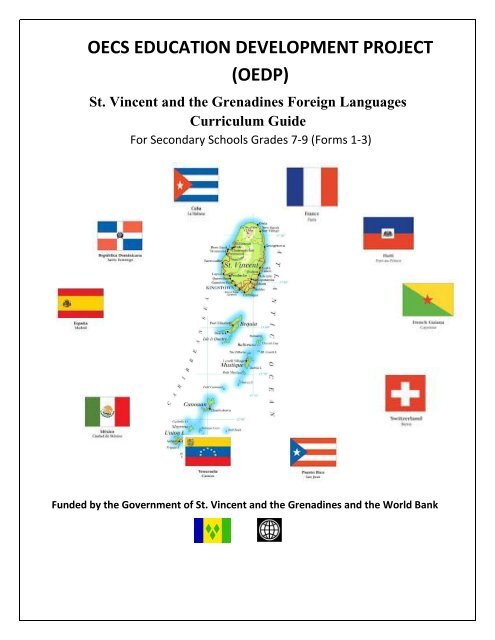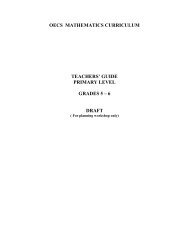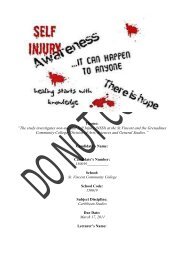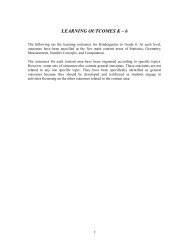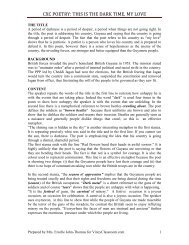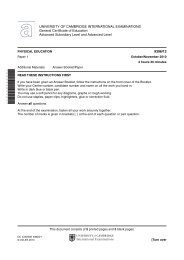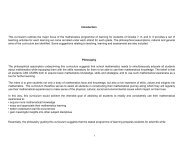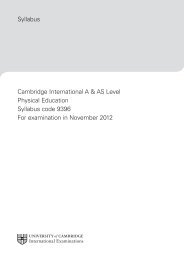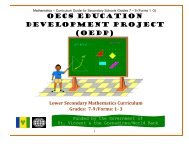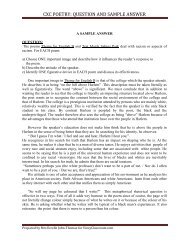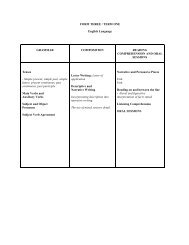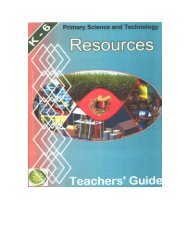oecs education development project (oedp) - VincyClassroom
oecs education development project (oedp) - VincyClassroom
oecs education development project (oedp) - VincyClassroom
Create successful ePaper yourself
Turn your PDF publications into a flip-book with our unique Google optimized e-Paper software.
ACKNOWLEDGEMENTSThe Ministry of Education extends sincerest gratitude to all teachers who in different waysassisted in the creation of this Curriculum Guide. Significant mention must be made to thefollowing persons who worked tirelessly to ensure the successful completion of this document:Lindsay Howard (Consultant/Advisor)Mrs. Sylvia Y Jack (Consultant/Advisor)Mrs. Deborah Bacchus- S.E.O CurriculumMrs. Flavia Haynes- HowardMs. Gloria WilliamsMr. Steve AustinMr. Fidel BaptisteMrs. Michelle BeacheMrs. Harriet Da SilvaMrs. Sylvia Sealey-JamesMs. Abigail ProvidenceMrs. Loretta Hamilton- RichardsMr. Darrel Williams
Message from the Chief Education OfficerMrs. Susan DouganGlobalization and the knowledge economy pose numerous challenges to small island developing states. St.Vincent and the Grenadines is no exception. With the transformation of entire economies and cultures, schoolsare expected to keep pace, and educators have to rethink and reform the <strong>education</strong> system to grapple with thesechallenges by increasing access and providing opportunities for the student population to acquire skills and gainknowledge for living and production.The curriculum is a powerful instrument through which <strong>education</strong> reform is pursued. The curriculum has toprovide opportunities for personalizing learning by introducing flexibility in what is taught. It has to be relevantand engaging for all pupils. The curriculum should create learning opportunities for each child by considering therange of abilities, aptitudes and diverse backgrounds of all students. The foundation skills - literacy, numeracyand ICT are also of utmost importance but initiative, creativity and problem solving must transform the way ofthinking and doing.The new curriculum and assessment framework makes provision for new approaches and the use of innovativemodalities to encourage teachers to change from traditional to interactive approaches; to foster critical thinkingand problem-solving while engaging teachers in proper assessment practices which will enable them to provideevidence-based-intervention strategies for all learners.The framework also allows practitioners to hone the latent energies and abilities of students through the design,technology, physical <strong>education</strong>, performing and creative arts curricula. This, it is hoped, will provide futurecitizens with skills and knowledge to be employable, competitive, self-sufficient and to increase civic anddemocratic responsibility.Through the use of this curriculum, from Kindergarten to Grade 9, the <strong>education</strong> received will determine thecitizens’ capacity to prosper and to help the economy to bloom.The new thrust to introduce teachers’ guides into schools strengthens the initiative to provide the appropriateresources to allow teachers to implement all programmes of learning. I urge teachers to make maximum use ofthese resources so that the nation’s children will continue to benefit from the opportunities provided in allclassrooms.Susan DouganSusan DouganChief Education Officer
FOREWORDThe phased introduction of Universal Secondary Education (USE), completed in 2005, highlighted the need forappropriate curricula to meet the varying needs and interests of the increased, more diverse student populationentering secondary schools.USE led to a further fragmentation of the current curricula as different secondary schools adopt different copingstrategies to meet their diverse students’ needs.Hence for USE to be deemed effective there was an urgent need for the Government of St. Vincent and theGrenadines and in particular the Ministry of Education to provide a uniform curriculum framework for allsecondary schools, thus providing more equitable access for all.The Education Act of 1992 and the ESDP (2002-2007), sought to address these issues by providing for the<strong>development</strong> of a National Curriculum and Assessment Framework (NCAF), which provides flexibility forschools to customize the curriculum, subject to policy requirements, to best meet the needs of their students.This National Framework, developed through a wide-ranging consultative process and participatorymethodologies, led to the <strong>development</strong> of National Curriculum Programmes of Learning (POLs) and TeachersGuides in nine (9) subject areas: Creative Arts (Dance, Art, Drama and Music), Design and Technology, ForeignLanguages (French and Spanish), Health and Family Life Education, Language Arts, Mathematics, PhysicalEducation and Sports, Science and Social Sciences.These Programmes of Learning seek to raise the performance and standards of teachers and students byproviding Attainment Targets and basic Learning Outcomes and Achievement Indicators that ALL students areexpected to achieve.The Attainment Targets describe what each student should know, be able to do and the desirable attitudes theyshould display.The Learning Outcomes are derived directly from the Attainment Targets. They indicate the basic depth andbreadth of what students should know, be able to do, and the desirable attitudes they should demonstrate.The Achievement Indicators state what the students should know, be able to do and the values and attitudes theymust display in order that the teachers and students can know that a Learning Outcome has been achieved.The Teachers’ Guides are designed to enable ALL students to achieve the national goals for secondary<strong>education</strong>. They aim to illustrate the integration of teaching, learning and assessment.Each Guide has been designed to suit the particular needs of each subject area. Furthermore, the Guides includesample lesson plans, assessment strategies, activities and the major resources/materials needed to effectivelydeliver the programmes. These documents should therefore serve as a guide for the <strong>development</strong> of instructionalprogrammes to be implemented at the classroom level.These Guides should therefore provide opportunities for the enhancement of teaching and learning at theclassroom level and so contribute to the cognitive, affective and psychomotor <strong>development</strong> of the child.
The teacher, the main user of these Guides is envisaged as someone who:Plans for teaching according to different learning styles and needs of his/her studentsIs flexible and creativeIs knowledgeable of the subject he/she teaches.The teacher of the NCAF is therefore someone who is confident in the delivery of the subject matter.At the Ministry of Education, we are confident that these Guides will significantly enhance teaching and learningin secondary schools and eventually contribute towards the achievement of school graduates who are:-Literate and numerate in all domainsCapable of sound moral and ethical judgmentsConfident and emotionally secureCapable of working independently and cooperativelyLifelong learnersHardworking with positive work ethicsKnowledgeable and appreciative of their creative and artistic expressionsIt is our hope that principals and teachers continue to play their roles in ensuring that these Guides are used forthe enhanced <strong>development</strong> of the Nation’s children as we work together to produce better citizens in St. Vincentand the Grenadines.D. BacchusDeborah Bacchus (Mrs.)Senior Education Officer – Curriculum
Overview of the Curriculum GuideIt is important to note that the Curriculum Guide is set out in Year levels (Years 1, 2 and 3)instead of Grade levels (Grades 1, 2 and 3) or Form levels (Forms 1, 2 and 3). Thisapproach facilitates what now exists in the Secondary School System where all schools donot begin French and Spanish in the first year – Grade 7/Form 1.The Curriculum Guide contains the Programmes of Learning contains suggested relatedgrammatical structures and vocabulary, resources and activities for teaching andassessment.Aspects: The rationale for foreign language learning/teaching Approaches to foreign language learning/teaching Model lesson plans Suggested forms of assessment and activities on subject matter taught Suggestions for resources which may be used in each strandThemes:The major themes to be covered in the three year period of learning are: Personal Information Communicating for social interaction Culture: The cultural aspects are to be included should relate the civilization tocountries where the target language is the official language, for example, Europe,Latin America, France, French West Indies Activities involving the use of numbers is necessaryKindly note that material included is not exhaustive and that teachers may include what isdeemed relevant in the teaching-learning context. Remember to include activities whichdraw on the psychomotor <strong>development</strong>.The use of the Total physical response (TPR) is manifested in commands, where theobjective would be to respond to the correct command. One of the ways this could bedone would be to give the students cards with verbs or other words. Then, have somestudents give commands according to the cards or pictures. 9Example given in French: Sortez/ sors/ entrez/ entre/assieds-toi/ touchez le bras/ touchela tête, etc. Example given in Spanish: Toca/ salten/ siéntate/Adelante/


